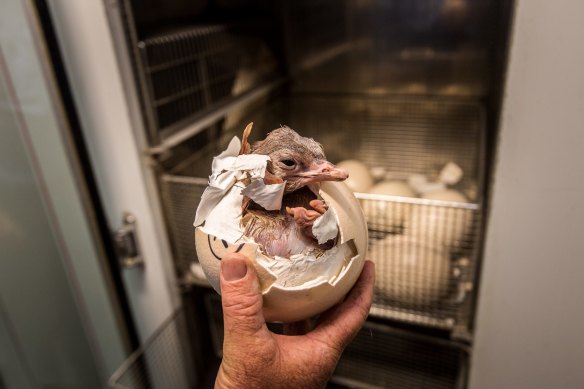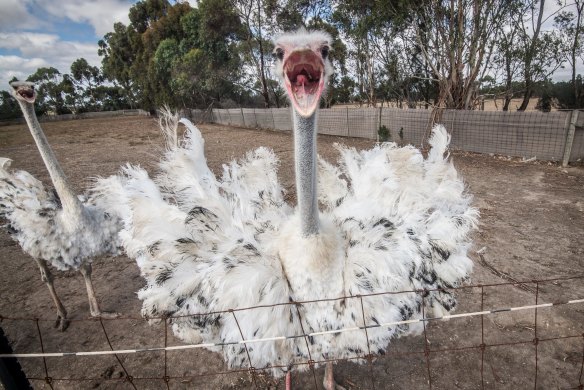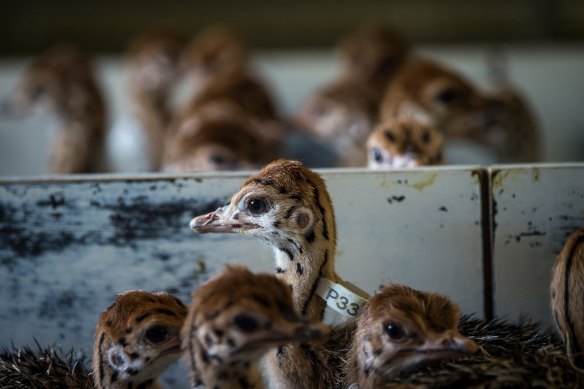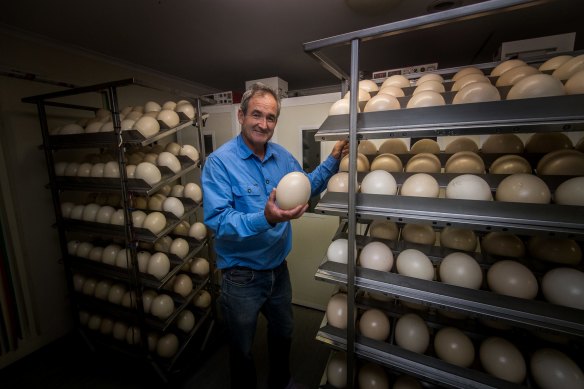'Eye fillet steak crossed with duck': Ostrich is on the menu

What is polyamorous, has long legs and wears red lipstick and white feathers?
A male ostrich.
"As he comes into mating season, the lipstick goes from pale pink to bright red, that shows his testosterone levels," says Winchelsea ostrich farmer Michael Hastings.

It's breeding season at Australia's last commercial ostrich farm, on Victoria’s surf coast.
This year, the family business is celebrating three decades of breeding and selling ostrich products: meat, leather, feathers and genetics.
"The beauty is you can use every part of the bird," Hastings says.

The proof could soon find its way on to the plates of Sydney cafes, with plans to use the eggs in a meal that would give a whole new meaning to the term "big breakfast".
Robert Serratore from Platform 82 in Sydney's inner west first made inquiries about getting ostrich eggs in his cafe about a year ago.
"I saw it on Instagram and thought it was great," he said.

While the logistics are yet to be finalised, he envisions a platter-sized offering for six cafe-goers to share.
The meat will make an appearance at the Melbourne Food and Wine Festival in March, as the owners of African restaurant Polepole fought hard to secure fillets for their menu.
Head chef Felipe Bley, who will serve the meat with caramelised parsnip puree, recommends cooking ostrich on a hot barbecue.
"If I could, I would buy it for my house. I would love to eat it on a daily basis," says Bley, who is originally from Brazil. "The problem is the supply."
Until recently, Hastings has focused on exporting meat to Europe, Japan and Canada as demand is high and he can get good returns. But the drought and outbreaks of bird flu have caused him to focus on the domestic market.
"The drought has nailed us; our feed prices have doubled," he says. "I need an insurance plan."
In November, he began selling ostrich meat to Salami Shack, a husband-and-wife team who sell cured meats at farmers’ markets. They now sell three styles of ostrich salami and there are plans to launch a chorizo next month.
"Some people can’t believe how good it is," says Salami Shack owner Greg Little.
Since launching the product, they’ve had to increase production three-fold as initially sceptical customers have become hooked.
Often confused with the gamey, strong flavour of emu, ostrich is a red meat more like beef: lean, high in protein, and low in cholesterol and fat.
"It's like an eye fillet steak crossed with duck," says Leonie Mills, who teaches students to cook with the meat at the Gordon Culinary School in Geelong.
Mills has become an advocate for the lean meat after discovering it while running a cafe in Geelong. She says the flavour is brilliant and the meat is sustainable.
"I think it needs more public awareness. People don't really realise how nice it is," says Mills.
The flightless birds drink far less water than cattle, produce no methane, require less land and can grow to 100 kilograms in 10 months.
"Often you'll have a fairly sustainable animal but you have to do quite a lot to the meat to get it palatable, but ostrich is brilliant," says Mills.
As Australia's sole ostrich producer, Hastings is struggling to keep up with demand. He says ostriches aren't the smartest animals and rearing them requires hands-on work that keeps him busy from dawn to dusk.
"We have to do everything: all the genetic work, breeding, incubation, hatching, rearing, growing, trucking, processing."
He receives weekly phone calls from restaurants and cafes across the country wanting to buy ostrich meat and more recently, eggs.
Overseas, cafes have been serving ostrich eggs as a novelty and Hastings is working overtime to produce a bird that can kickstart the domestic egg market.
With a flavour similar to chicken eggs, the ostrich produces the largest egg in the world. An egg from an ostrich is the equivalent to two dozen chicken eggs, and Hastings' freezer is filled with ostrich egg quiches.
His own genetic creation, the ostrich dubbed the Hasting White was initially bred for its white feathers but more recently, he has been using the birds for egg production as they are smaller and reliable hatchers.
